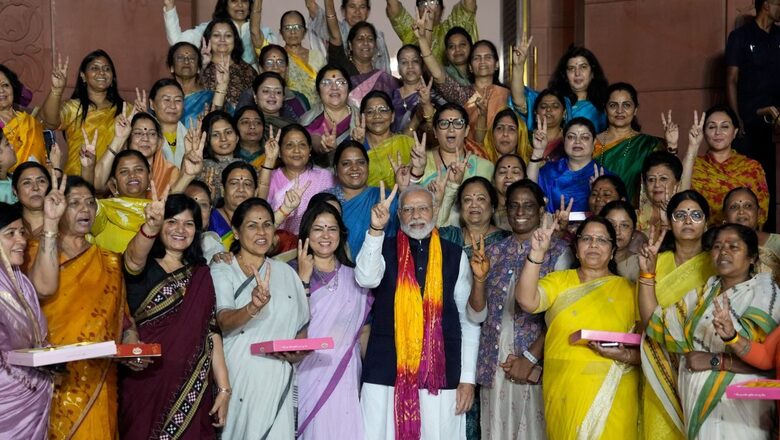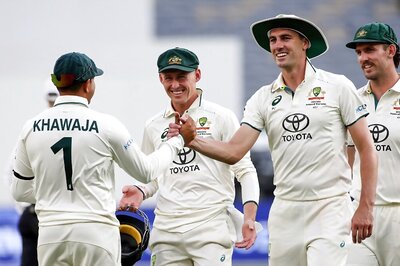
views
On Thursday, September 21, 2023, India awakened to a new dawn to the tune of the national song ‘Vande Mataram’ after achieving what was considered impossible for decades. Indeed, it is a day of great national awakening and celebration with the moment of the greatest gender empowerment in the nation since independence.
Vande Mataram
On September 20, the special Parliament Session ended with declaring Lok Sabha adjourned sine die by Speaker Om Birla. And on September 21, the Rajya Sabha was adjourned sine die by Jagdeep Dhankhar, Chairman of the Rajya Sabha and Vice President of India. Both Houses were adjourned after the rendition of the national song ‘Vande Mataram’, written by Bankim Chandra Chatterjee in 1882 and adopted by the Constituent Assembly on January 24, 1950.
The Moment that the Nation Waited For Decades
The highlight of the day was the passage at 2330 hours of the Nari Shakti Vandan Adhiniyam, the Constitution (128th Amendment) Bill, 2023 by the Rajya Sabha. The historical bill was passed unanimously in the House of Elders (214-0-0) with no member either opposing the Bill or abstaining from the voting. On September 20, 2023, the Bill was passed by the Lok Sabha with the support of a two-thirds majority of the members present and voting (454-2).
A Monumental Occasion
After the passage of the bill in the Rajya Sabha, Prime Minister Narendra Modi befittingly called the moment “a defining moment in India’s democratic journey”. It was an apt description because, notwithstanding the clamour of various Opposition parties for the reservation within the reservation for OBC women and the implementation without waiting for the delimitation, when boiled down to the actual voting for the bill, it was unanimous in the Rajya Sabha and near unanimous in the Lok Sabha.
What a Time
The passage of the bill makes India one of the top-performing nations in the world in facilitating women’s political empowerment, leaving behind major developed countries like the US, France, the UK, Germany, and Japan. What an opportune time. The historicity of the moment reminds me of two recent special moments.
One, for Bihar, February 14, 2023, was a day without parallel. On that day, out of the total 16.35 lakh students who appeared in the matriculation examination, for the first time in history, there were more girls (8.31 lakh) than boys (8.06 lakh).
Two, in the 2019 Lok Sabha Elections, after seven decades and 17 general elections since independence, women voter participation was at 67.18 per cent, outshining male participation at 67.01 per cent. It is instructive to note that in the 1957 general elections, women’s voting percentage was 39 per cent compared to 56 per cent of men.
Women Candidates in General Elections
The greater participation of the women notwithstanding, the voting never materialized in the improvement in either the women’s candidature or representatives in Lok Sabha. Before the 2019 elections, the percentage of women candidates never went beyond 7 per cent of the total candidates. From 1952 to 1989 general elections, the total number of women candidates was only 3 to 4 per cent. The last six general elections witnessed a steady increase in the number of women candidates from 4.2 per cent in 1996 to 7.5 per cent in 2014. There was a total of 8,039 male candidates in the 2019 general elections which is more than double of total women candidates put together in all general elections.
It is instructive to note that despite women accounting for nearly 50 per cent of the population, representation of women in both Lok Sabha and Rajya Sabha has been highly inadequate. In Lok Sabha, it began with a poor 5 per cent in 1951 and has reached the peak of 15 per cent in the current Lok Sabha. It was only in three Lok Sabha elections (2009, 2014 and 2019) that women member percentage crossed 10 per cent.
Contrarily, the House of Elders had a more auspicious beginning with 6.9 per cent members in 1952, 10.2 per cent in 1960 and peaked at 12 per cent as early as 1980 and 12.7 per cent in 2014. But since then, it has dwindled to 10.2 per cent in 2020.
No Substitute to Women’s Reservation
In light of the extraordinarily poor representation of women in Lok Sabha (and worse in state assemblies), if India had to bring a semblance of gender parity in Lok Sabha and state assemblies, empowerment through the reservation was the sole option left. And it has not come any sooner in the day.
Success Has Many Fathers and Mothers
It is intriguing that the political dispensation of all hues have tried to appropriate the bill as their own. But the truth beckons, those issues relating to ensuring greater representation of women in politics were nothing new. It had been discussed even before independence and in the Constituent Assembly. In independent India, the issue got some traction from the 1970s onwards. As early as 1975, the Committee on the Status of Women in India (CSWI) ‘Towards Equality’, finally brought out comprehensively that that the Indian state had failed in its constitutional responsibility to ensure gender equality.
The Seedling
Indubitably it was the 73rd and 74th Constitution Amendment Acts, enacted when P V Narasimha Rao was the Prime Minister, that mandated the reservation of one-third of seats for women in Panchayati Raj institutions and offices of the chairperson at all levels of Panchayati Raj institutions, and in urban local bodies respectively, which sowed the pathway for the eventual reservation for women in Lok Sabha.
Twenty-Seven Year Long Journey
It was only on September 12, 1996, that the UPA government headed by Prime Minister H D Deve Gowda tabled the Constitution (81st Amendment) Bill, which sought to reserve one-third of seats for women in Parliament and state legislatures. The bill was examined by a select committee of Parliament consisting of 21 Lok Sabha and 10 Rajya Sabha members. The committee was headed by veteran CPI leader Geeta Mukherjee and members included Sharad Pawar, Nitish Kumar, Mamata Banerjee, Uma Bharti, and the late Sushma Swaraj.
The bill was tabled in both Houses on December 9, 1996. With the government losing steam for the bill, it got shelved. When the bill was revived by the next Prime Minister, Indra Kumar Gujral, it fell flat on the issue of OBC quota and with the eventual withdrawal of the Congress support from the Gujral government and the dissolution of Lok Sabha, the women’s reservation bill too died sine die.
Vajpayee Era
Twice on July 20, 1998, and December 23, 1999, Atal Bihari Vajpayee in his two governments got the Women’s Reservation Bill introduced. Amid the high drama of RJD members tearing the copy of the first bill, it lapsed when the government lost the majority by one vote. The second bill too proved a road to nowhere. On March 7, 2003, Prime Minister Vajpayee made one last-ditch attempt to build a consensus at an all-party meeting without success and the NDA lost power in the 2004 elections.
The Gill Formula
Chief Election Commissioner MS Gill came up with the formula proposal of making it binding on political parties to give quota to women in ticket distribution. It remained a non-starter.
Manmohan Singh Government – No Show in Lok Sabha
On May 6, 2008, the UPA government introduced the Constitution (108th Amendment) Bill, 2008 in Rajya Sabha to reserve one-third of all seats for women in Lok Sabha and the state legislative assemblies. The Bill was passed by Rajya Sabha on March 9, 2010, but the politics of the reservation ensured that there was no show in Lok Sabha, where it was never brought and the bill lapsed with the dissolution of the House.
BJP Manifesto 2014 and 2019
The BJP’s manifesto ‘Sankalp Patra’, both in 2014 and 2019, committed the party to bring 33 per cent reservation in parliamentary and state assemblies through a constitutional amendment. But the government could not bring the bill till the current Special Session of the Parliament. The sheer fact that the bill was approved by the Union Cabinet on September 18, passed nearly unanimously by Lok Sabha on September 20 and unanimously by Rajya Sabha on September 21 shows not only the commitment of the government but the sagacity of the political parties of all hues that makes the passage of the bill truly momentous.
The Journey Has Just Begun
It has taken 76 years for all political parties to sink their difference and finally put their weight behind the greatest gender empowerment moment in India and unequivocally support the bill. So far so good. But the journey has just begun. The implementation will be possible only in the 2029 General Elections post the 2024 Census and subsequent delimitation. What till then?
Time to Voluntarily Bring Back Gill Formula
The nation need not wait till 2029. It is time for political sagacity, and unanimity maturity once again. It is sad that India, that is Bharat, had to wait for 76 years to see this day of reckoning. The momentous moment calls for all political parties to move up the politics of reservation voluntarily and give a minimum of 33 per cent of seats in all the elections starting the 2024 General Elections to women.
The Real Victory will be when…
I am born incorrigible optimist. A 33 per cent reservation is a no-brainer for me. I began this piece with how women in the 2019 Lok Sabha Elections trumped men with 67.18 per cent coming out to vote. I will wait for that day to arrive when the number of Nari Shakti in Lok Sabha crosses 51 per cent. Waiting for the D-Day to finally arrive.
Akhileshwar Sahay is a Multi-Disciplinary Thought Leader and India Based International Impact Consultant. He works as President Advisory Services of Consulting Company BARSYL. Views expressed in the above piece are personal and solely that of the author. They do not necessarily reflect News18’s views.

















Comments
0 comment